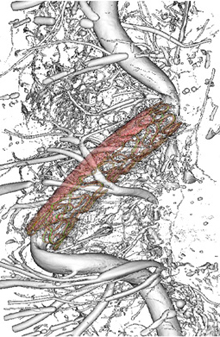Novel cell therapy devices and isolation strategies
In 1999 we developed the concept of a mesh-stent that would allow percutaneous delivery of millions of cells or genes to any site in the vasculature that could be accessed with an interventional device over a wire. We filed a patent on this technology and subsequently showed in a pig model that stable protein could be expressed in millions of engineered smooth muscle cells over a 1 month period in vivo. Since then we have developed and refined this technology for delivery of therapeutic genes such as VEGF in chronic vascular occlusions and have shown marked improvement in perfusion parameters in a porcine model of chronic vascular occlusion within 4 weeks of delivery of VEGF engineered smooth muscle cells in a mesh-stent. It is anticipated that this preclinical work can result in a phase I clinical trail of an angiogenic stent.
We have also submitted patent applications on specific smooth muscle progenitor cells and a new device coating that will potentially inhibit smooth muscle progenitor accumulation on stents. Our data suggest this process may constitute a major cellular component of restenosis after stent placement. Our stent coating is unique and significantly differentiates us from current drug eluting stent technologies used by industry which are based on polymer elution of either cytostatic (rapamycin) or cytotoxic (taxol) compounds. Finally we have recently defined the surface integrin and in vivo homing characteristics of human smooth muscle progenitor cells which may allow directed targeting of these cells as therapeutic vehicles to devices in vivo.

